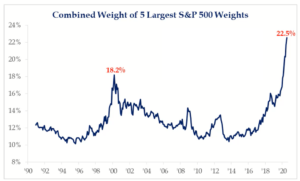Watching Your Weight and the S&P 500
July 21, 2020
To Inform:
For fun, let’s start this Wealthnotes with a multiple-choice question.
Which of these is correct?
- A. The S&P 500 was down – 3.1% for the 2020 year to date period ending June 30
- B. The S&P 500 was down – 10.8% for the 2020 year to date period ending June 30
- C. Both A and B are correct, which makes no sense, but it is part of the hook to get me to read the rest of the article
Answer: C – both A and B are correct!
You are probably thinking, okay that really does not make any sense. It’s about a 7% difference between the two numbers, so how can they both be correct? There has to be more to the story here. Well, there is more to the story and it all comes down to how the stocks within the index are weighted.
The S&P 500 Index, which is a broad index investors use to measure the performance of the U.S. stock market, consists of the 500 largest publicly traded companies in the United States. The mainstream S&P 500 is market-capitalization weighted, which is a fancy way of saying that the larger the company, the bigger the weight it has in the index. Recently, leadership in the stock market has been found in technology stocks and a number of large technology companies were among the first to recover after the COVID-19 induced market plunge in March. As a result, the market capitalization (which is calculated by multiplying the current stock price by the number of outstanding shares) of these technology companies has grown and their stocks are occupying a bigger weight in the S&P 500 Index.
Currently, the five largest publicly traded companies in the United States, which are all tied to the technology and ecommerce fields, occupy the biggest proportion of the S&P 500 index in history. As shown in the chart below, the Top 5 companies within the S&P 500 make up 22.5% of the index. Simple math means the remaining 495 companies make up the remaining 77.5% of the index.

Source: Strategas Research Partners
Another way to look at the S&P 500 is on an equal-weighted basis. Rather than weight the companies by size, we can take the same 500 companies and give them all an equal 0.2% weight (100% / 500 = 0.2%) in the index computation. The equal-weighting methodology is not as popular in the mainstream financial media, but there are a number of exchange traded funds (ETFs) which invest in the 500 stocks within the S&P 500 on an equal-weighted basis.
Going back to the multiple choice question, in both answer choices A and B, we are looking at performance for the same 500 companies, but choice A uses a market-capitalization weighted methodology (and is down -3.1% for the first half of the year) but choice B uses an equal-weighted methodology (and is down -10.8% for the first half of the year).
The implication of the difference between these two numbers is the average stock has simply not performed as well as big technology companies so far in 2020. Some may say the dominance of big technology companies has skewed the performance of the S&P 500 Index.
Jason Trennert, Managing Partner of Strategas Research Partners questions whether putting such a big emphasis on only five stocks makes sense for most investors. In an article late last week, Trennert asked “would any risk manager or investment consultant ever consider it prudent for an active manager to have nearly 25% of their holdings in merely 1% (5 out of 500) of the positions that make up a portfolio?”
The gap in performance is certainly something we are paying attention to. On one hand, we are very cognizant trends, especially in technology, have been accelerated by COVID-19 and the associated economic lockdowns. On the other hand, when investing over the long-term, valuations matter. The last time the weighting of the Top 5 companies in the S&P 500 reached a peak was in March of 2000 (with technology stocks also leading the charge) when the concentration of the Top 5 reached 18.2%. The years which followed were a time when smaller companies outperformed.
The bottom line is, we are watching our weight – the weight of companies in our portfolios that is. Big technology companies have had incredible performance momentum the last few months and we think their role in the global economy is important. However, better forward-looking investment opportunities may be found in the other 495 S&P 500 companies and not just the five which are dominating the index.